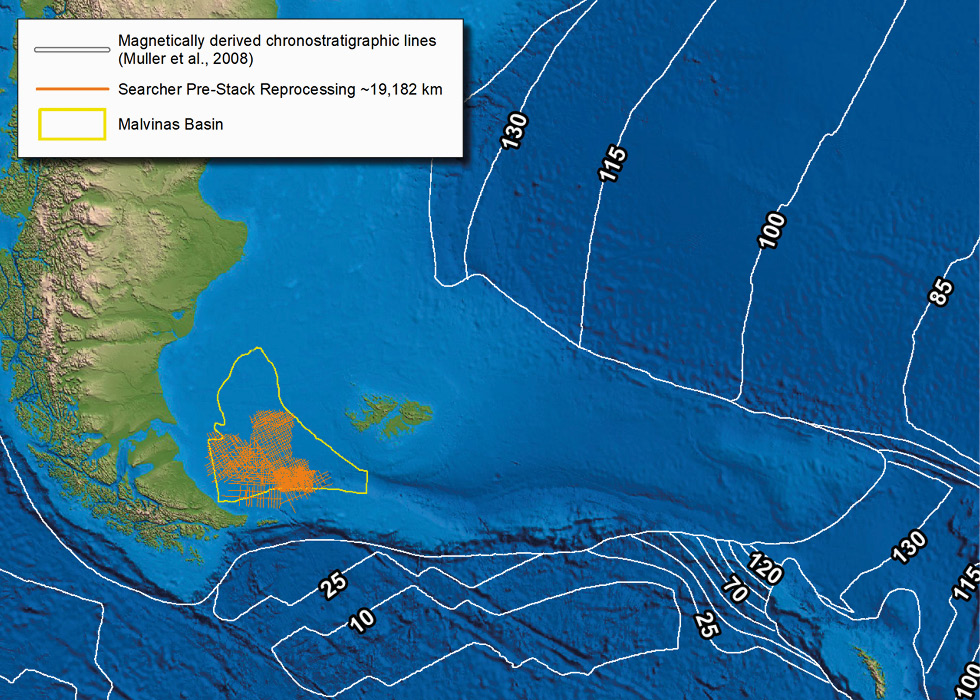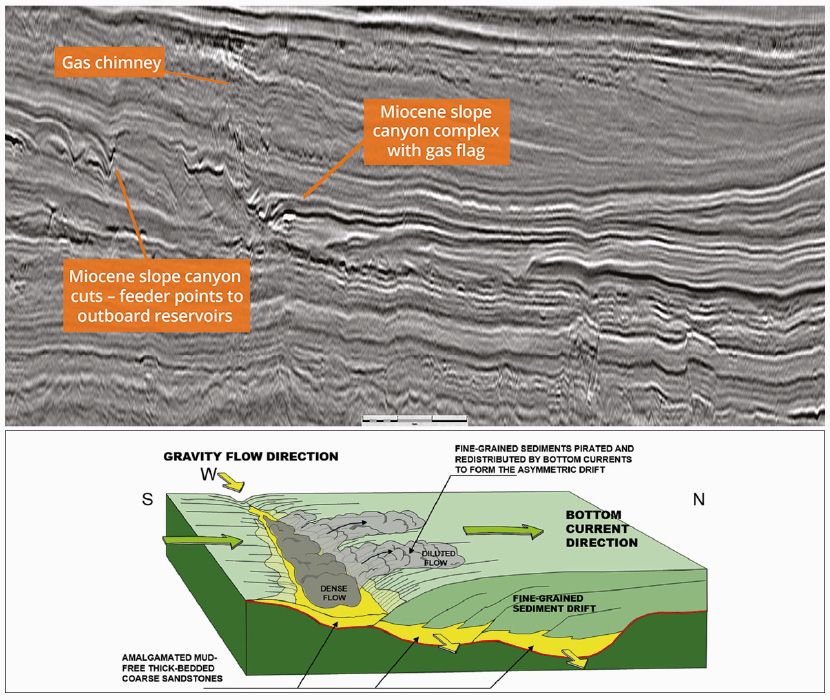Tertiary hydrocarbon prospectivity in the Malvinas Basin
Reprocessing of seismic data across the Malvinas Basin has aided in the definition of virtually unexplored Tertiary plays.
The Malvinas Basin is a large foreland sedimentary basin located entirely offshore on the Argentine Shelf of southern Patagonia. To the west the basin borders the Río Chico-Dungeness High, which separates it from the Magallanes Basin. The southern boundary is the Tierra del Fuego fold belt, formed by transpressive movement along the Scotia Plate boundary.
Setting the scene
The Malvinas Basin sedimentary succession can be divided into four tectonostratigraphic units: Jurassic rift deposits; Late-Jurassic to Cretaceous sag deposits; latest Cretaceous to Eocene transitional marine deposits; and the late Eocene-Pliocene foredeep deposits.
As Gondwana began to fragment during the Jurassic, rifting commenced across the Malvinas Basin and between Antarctica and South America. Jurassic volcaniclastic sediments and potential lacustrine source rocks of the Tobifera Formation infilled the rifted topography in the Eastern Malvinas Basin. Through the Cretaceous however, deconstruction of the supercontinent was relatively quiescent in this area. Lower Cretaceous post-rift sag deposits form a backstepping siliciclastic marine wedge that was fed mainly from the North (Biddle et al., 1986). At the base of the section is the prolific traditional Springhill Formation target, which incorporates known source rock and reservoir sections of the adjacent Magallanes Basin and is covered by a marly aggradational interval deposited in neritic to open marine conditions. Relative accommodation space continued to increase into the Late Cretaceous with thermal sag and the deposition of predominantly open marine sediments.
It was only when South America began to accelerate westwards relative to Antarctica, about 50 Ma, that rifting began again south of the Malvinas Basin, opening a shallow (<1,000m water depth) Drake Passage. The accelerated oceanic crust formation led to uplift in southern Patagonia and erosion and deposition of marine turbidite sandstones into the Malvinas Basin during the Eocene. By 26 Ma rifting entered a spreading phase and the Drake Passage opening deepened to depths greater than 2,000m (Livermore et al., 2005), creating the first oceanic crust (Figure 1). This drifting led to the formation of the oceanic Scotia Plate, which, interestingly, could potentially be used as an analog for the formation of the Caribbean Plate.
At the beginning of Scotia Plate drifting, the formation of new oceanic crust was the main driver for the onset of tectonic instability in the Malvinas Basin, controlling the development of depositional systems. Syn-rift sandstones were eroded during the uplift of localized areas, as the Scotia extensional plate developed, and transpression on the northern margin of the Scotia Plate compressed the southern edge of the Magallanes, Malvinas and South Malvinas Basins. The foredeep created by this compression was infilled by shallow marine to basin floor clastic deposition until the Late Miocene.
The 35 Ma sequence boundary marks the top of the hydrocarbon-bearing Eocene sandstones encountered in the Salmon-2 well and also corresponds to the base of Oligocene to Lower Miocene sandstones from which hydrocarbons were recovered in the Ciclon-1 well. Searcher’s 2017 and 2020 seismic reprocessing indicates several deltas rapidly prograding within the Malvinas Basin (Figure 3). In places, these are sufficiently buried to offer exploration targets. Progradation of deltas continued during the Pliocene.
Prospective Tertiary hydrocarbon play levels in the Malvinas Basin
Two key potential Tertiary play intervals are identified within the Malvinas Basin:
- Paleocene to Eocene deep marine turbidite deposits
- Oligo-Miocene retrogradational basin floor fan, slope canyons and slope fan deposits.
Paleocene to Eocene-aged deep marine turbidite sandstones have been encountered in 23 wells within the Malvinas Basin ranging in thickness from 15m in Sirius X-1 to over 100m in Centauro X-1. Reservoirs are characterized by massive, amalgamated sandstones in the Paleocene and lower energy interbedded sandstones in the Eocene (Figure 4). Traps are generally stratigraphic or combination structural stratigraphic, with some relief provided by compressional topography, as seen on the foldout on the previous page. Top and lateral seals are provided by the transgressive and highstand Eocene deep marine shales or the progradational toes of the Oligo-Miocene deltas. Salmon X-1 produced oil and gas from excellent quality Paleocene sandstones proving the potential for this section as a viable exploration target in the Malvinas Basin.
The 35 Ma sequence boundary marks the base of Oligo-Miocene deltaic deposition. Progradation of the deltas occurs into the Malvinas Basin from north-west to south-east. Basin Floor Fans are observed on the reprocessed data, along with slope canyons and fans, and slope channel complexes, apparently influenced by contourite currents (Figure 5). Twenty-five wells have intersected reservoirs sandstones at this stratigraphic level, ranging in thickness from 20m in multiple wells to over 210m in Nerita X-1. Due to the retrogradational nature of deposition, sandstones in this section tend to be higher energy, thicker and more amalgamated than those deposited prior to the 35 Ma sequence boundary. Top seal is provided by the shaley progradational toes of subsequent deltas, and is therefore higher risk near shore, with the risk decreasing into the Malvinas Basin.
The sources for the hydrocarbon systems charging plays in the Malvinas Basin include lacustrine source rocks in the Jurassic Tobifera Formation, Early Cretaceous source rocks of the Springhill Formation and the Late Cretaceous Inoceramus Formation, and potentially additional prodeltaic source rocks in the Lower Tertiary.
Successful hydrocarbon exploration anticipated offshore Argentina
The tectonic influence of the rifting of the Scotia Plate from 50–35 Ma played a key role in the evolution of the Malvinas Basin and generated the right conditions for reservoir deposition and trap formation. Reprocessing of seismic data across the basin has aided in the definition of Tertiary plays which have been largely underexplored but partially proven by well results in the Malvinas Basin. Identification of shallow gas anomalies using deep machine learning has helped to de-risk the potential for Jurassic lacustrine source rocks to charge the Tertiary plays, suggesting that Tertiary play systems will underpin successful future exploration in the Malvinas Basin.
References:
- Palermo, D., Galbiati, M., Famiglietti, M., Marchesini, M., Mezzapesa, D. and Fonnesu, F. (2014). Insights into a new super-giant gas field-sedimentology and reservoir modeling of the Coral Reservoir Complex, Offshore Northern Mozambique. Offshore Technology Conference-Asia, 2014.
- Biddle, K. T., Uliana, M. A., Mitchum Jr, R. M., Fitzgerald, M. G., & Wright, R. C. (1986). The stratigraphic and structural evolution of the central and eastern Magallanes Basin, southern South America. Foreland Basins, 41-61.
- Livermore, R., Nankivell, A., Eagles, G., & Morris, P. (2005). Paleogene opening of Drake passage. Earth and Planetary Science Letters, 236(1-2), 459-470.
- Mukasa and Dalziel, 1996
- Müller, R. D., Sdrolias, M., Gaina, C., & Roest, W. R. (2008). Age, spreading rates, and spreading asymmetry of the world’s ocean crust. Geochemistry, Geophysics, Geosystems, 9(4).
- Orsi, M., Ciurlo, B., Fonnesu, F., Haliru, H., Meciani, L., Moltifiori, G. G., & de Finis, F. (2011) Mozambique Rovuma Basin: An Emerging World Class Gas Province. AAPG International Conference and Exhibition.
Further reading from Searcher on oil & gas exploration offshore Argentina
Prospectivity of the Malvinas Basin, Offshore Argentina
Dariusz Jablonski; Searcher Seismic
New regional reprocessed 2D seismic reveals the prospectivity and hydrocarbon potential offshore Argentina.
This article appeared in Vol. 15, No. 2 – 2018








